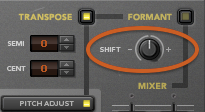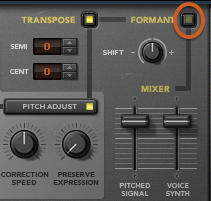About Formants
A formant is a resonant frequency present in many acoustic
sound sources, such as stringed instruments and voices. Formants
are often fixed in frequency, with the frequency determined by the
physical characteristics of a resonating body. For example, an
acoustic guitar has some resonant frequencies that are due to the
size and shape of the guitar box, and these frequencies are
emphasized regardless of the pitches that you play on the
instrument. Formant frequencies are partly responsible for the
characteristic sound of an instrument.
Voices are similar, with the additional complication that the
resonating cavity — the mouth and throat — changes
shape constantly to produce different vowel sounds. Each vowel you
sing has a characteristic set of formant frequencies, regardless of
the pitch you sing.
When you transpose the sound of a voice or an acoustic instrument,
you shift these formant frequencies by the same interval that you
shift the fundamental and its overtones. This can make a voice
sound unnatural: like chipmunks when you transpose higher, like a
monster when you transpose lower. Essentially, this is like
decreasing or increasing the size of the vocal cavity.
Neptune is capable of analyzing the formant frequencies of incoming
audio and preserving these formants while the audio undergoes
transposition. All you have to do to make this happen is turn the
FORMANT switch on (as shown in the first picture on this page).

You can also achieve creative effects, such as gender changing, by
using the SHIFT knob, which shifts formant frequencies higher or
lower than they were in the original sound. This happens
independently of other transposition that Neptune performs.






